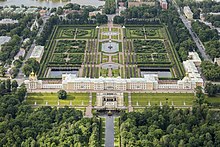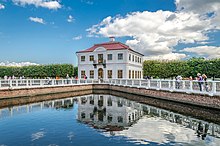Peterhof Palace
The Peterhof Palace ( Russian Большой петергофский дворец Bolshoi Petergofski Dworez , German 'Great Peterhof Palace' ) is a former summer residence of the Russian tsars on the Gulf of Finland in Peterhof , about 25 km west of Saint Petersburg .
The complex was built on the occasion of the Russian victory in the Great Northern War based on the architectural model of the Palace of Versailles and based on designs by Peter the Great . The palace and park were built in several sections from 1715 to 1755 according to plans by Johann Friedrich Braunstein , Jean-Baptiste Alexandre Le Blond , Nicola Michetti and Bartolomeo Francesco Rastrelli in the Baroque style.
In the Second World War , Peterhof was destroyed by the German Wehrmacht and then rebuilt by Soviet restorers. The ensemble, also known as the “Russian Versailles”, has been a UNESCO World Heritage Site since 1990 and one of the Seven Wonders of Russia since 2008 .
History of the castle
Shortly after founding his new capital, Saint Petersburg, Peter I had a small country house built here on the southern coast of the Gulf of Finland, where he often took a break on the way to or from the Kronstadt fortress .
After the victory over the Swedes at the Battle of Poltava in 1709, the Tsar decided to build a contemporary residence that would become a symbol of Russia's new great power . In 1714, the planning for the new palace began , on which Peter, who had already dealt with various handicrafts on a long tour through Europe, actively worked and for which he sought advice from Andreas Schlueter and his pupil Johann Friedrich Braunstein .
Peterhof was inaugurated in August 1723. The construction work on the large, but quite simple castle was not yet fully completed at this point in time. In addition to the actual palace, the Golden Cascade and a large part of the Lower Park were laid out, the 400-meter-long canal to the Baltic Sea was excavated and work on the pleasure palaces Monplaisir and Marly , a reminiscence of the Marly-le-Roi palace by Louis XIV. , largely ended. After the inauguration, Peter I used the palace, which was decorated in baroque style, as his summer residence , while he spent most of the rest of the seasons in the Winter Palace . The castle and the park were continuously expanded and embellished in the period that followed.
After the death of Peter I in 1725 the palace stood empty for a few years. Only in 1730 did Tsarina Anna resume work on the castle. Under Tsarina Elisabeth , the short side wings were added to the Grand Palace, which was previously only about as wide as the cascade in front, by Bartolomeo Francesco Rastrelli , the main building was lengthened and heightened and the pavilions were erected at the ends of the structure, one of which included the palace church. This work lasted from 1747 to 1752 and gave the elongated, yellow-washed building with the white decorations its present form. In addition, Catherine the Great made some embellishments. The Russian tsars built this residence well into the 19th century , which they inhabited again and again at irregular intervals and which has magnificent parade rooms such as the Golden Hall, the Throne Room and the mighty staircase, but which also houses the more intimate living rooms of the Russian ruling family, like the bedroom of Peter the Great.
During the Second World War , Peterhof was largely plundered and destroyed by the German occupiers. At the end of June 1941, museum employees tried to evacuate most of the art treasures. Some were brought to Leningrad, others were lost in the transport. Peterhof Palace was occupied from September 23, 1941. When a bullet struck that evening, the palace caught fire.
During the occupation of the palace, the Leningrad blockade began , in which between 800,000 and 1.5 million people died. The German Wehrmacht converted the destroyed Peterhof Palace into a base, dug anti-tank trenches through the park, laid mines and laid barbed wire. A systematically organized art theft was supposed to take place, but various other troop units had already stolen many art objects. It was not until January 19, 1944, after the end of the Leningrad blockade, that the Wehrmacht withdrew from Peterhof.
The clean-up work began immediately after the end of the war, and parts of the Lower Garden were reopened to visitors after its reconstruction in the summer of 1945. The museum management decided to rebuild the Great Cascade first. Half of the figures survived the war, and large sculptures were buried in the park. Adam and Eve were found, the central figure of Samson has not been found up to the present day. It has been replaced by a replica. The Neptune Fountain , a Nuremberg product from 1667, which Tsar Paul I bought from the city, was stolen by the Wehrmacht, brought to Nuremberg and restituted after the war .
The restoration work on the castle lasted for many years and has not been fully completed to this day (as of 2014). On the one hand, the destroyed works of art had to be painstakingly reconstructed, and on the other hand, the financial means were always tight. Many art treasures are considered lost to this day.
The palace and its gardens, park castles and water features represent one of the most important destinations for tourism in Russia today.
Description of the park
The Peterhof Palace Park is divided into the Lower Garden, which is dominated by the Golden Cascade and the canal to the Baltic Sea, and the Upper Garden, which is in front of the front of the palace. The entire garden is characterized by the original water features with 176 fountains , which are fed via an ingenious underground pipe system from springs 25 km away and function exclusively through the natural gradient. In Peterhof , the baroque Neptune Fountain, originally from Nuremberg , is also arranged as a classical garden fountain. (A second casting of the fountain is in Nuremberg.)
The upper garden, decorated with bosquets , trimmed bushes and old trees, lawns, large pools and gilded statues and vases, corresponds to a typical French baroque park . The lower garden, which also houses many of the park buildings, is adorned by ornate broderie parterres in front of the palace hill . It is also structured by a shady bosque and adorned with numerous water features. The pictorial program of the depicted scenes is geared towards Peter I. For example, the Samson Fountain from 1734 in front of the Grand Palace symbolizes the victory at Poltava over Sweden (1709). Here Peter is portrayed as a biblical hero who opens the mouth of the Swedish lion and defeats him.
The Lower Garden was considerably enlarged by Catherine the Great. She added a large landscaped garden to the originally Baroque park.
To the east, the picturesque Alexandria Landscape Park adjoins the Lower Garden. On behalf of Nikolaus I , the Prussian architect Karl Friedrich Schinkel made designs for the neo-Gothic Alexander Nevsky Chapel, which was started by Adam Menelaws between 1831 and 1833 and executed by Josef Charlemagne after his death in 1831 .
The gardens were awarded the European Garden Prize in 2017 in the category “Best restoration or further development of a historical park or garden”.
The film Magical Gardens - Peterhof by Emmanuel Descombes shows the palace, the park (based on an animated park plan) and its water art in the summer of 2016. Those responsible for the museums there are interviewed.
See also
- Fountain of Neptune (Saint Petersburg)
- Umbrella (joke fountain)
- Catherine Palace
- Lomonosov
- Snamenka Castle
- Strelna
literature
- Irina Paščinskaja: Festive illuminations in the lower garden of Peterhof in the first half of the 19th century . In: The garden art . 25 (1/2013), pp. 181-204.
- Stanislav Savickij: Cultivated relaxation versus reflection. Function and perception of the Petershof park in the mid-1930s . In: The garden art. 25 (1/2013), pp. 239-248.
Web links
- Peterhof Palace website (Russian)
- Peterhof near Saint Petersburg. In: RusslandJournal.de. Retrieved December 27, 2018 .
- Tsar residence Peterhof - radiantly beautiful. Petersburg Info, 2017, accessed December 27, 2018 .
- Peterhof Palace in the online encyclopedia Saint Petersburg (English, Russian )
Individual evidence
- ↑ https://peterhofmuseum.ru/objects/peterhof/bolshoy_petergofskiy_dvorets
- ↑ https://whc.unesco.org/en/list/540
- ↑ a b c d Johannes Voswinkel: Gold to ashes, ashes to gold . In: The time . January 16, 2014, p. 16
- ↑ From Ropsha (Russian Ропша) in the Lomonossow district
- ↑ Director: Emmanuel Descombes (* May 8, 1966), France, 2016, 27 min. Information from the broadcaster arte (F) about the film, May 2018 ( Memento from May 25, 2018 in the Internet Archive )
Coordinates: 59 ° 53 '0.3 " N , 29 ° 54' 27.2" E






